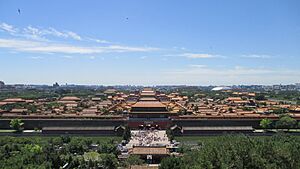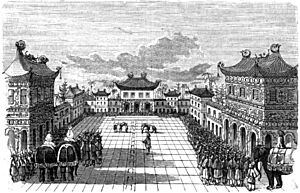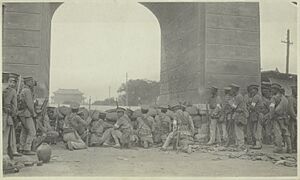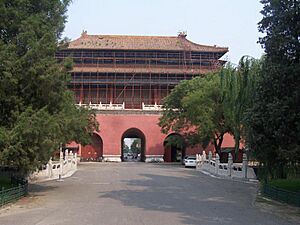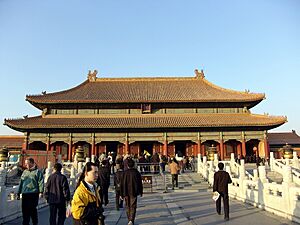History of the Forbidden City facts for kids
The Forbidden City is a huge palace complex in the center of Beijing, China. It was the home of Chinese emperors for almost 500 years, from the Ming dynasty (starting in 1420) to the end of the Qing dynasty in 1912. Even after that, the last emperor, Puyi, lived there until 1924.
Since 1925, the Forbidden City has been a famous museum called the Palace Museum. In 1987, UNESCO named it a World Heritage Site, which means it's a very important place for everyone to protect.
Contents
Building the Forbidden City and the Ming Dynasty Era
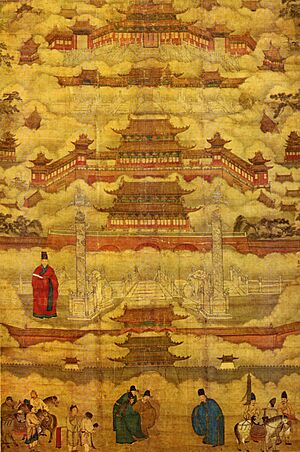
The land where the Forbidden City stands was once part of the capital city during the Mongol Yuan dynasty. After the Yuan dynasty ended, the first Ming emperor, Hongwu, moved China's capital south to Nanjing. He ordered the old Yuan palaces to be torn down.
Later, his son, Zhu Di, became the Yongle Emperor. He decided to move the capital back to Beijing. In 1406, he began building what would become the Forbidden City. Many skilled architects and designers helped plan the palace.
How it was built
Building the Forbidden City took 14 years, from 1406 to 1420. It was a massive project! About 100,000 skilled craftspeople and up to a million workers helped build it.
The huge pillars in the most important halls were made from special Phoebe zhennan wood. This wood came from jungles in southwestern China. Moving these giant logs was incredibly difficult.
The large stone carvings and terraces were made from quarries near Beijing. To move the biggest stones, workers dug wells along the path. In winter, they poured water from the wells onto the road, creating a layer of ice. Then, they dragged the heavy stones along the ice!
The floors of the main halls were paved with special "golden bricks." These bricks were made from clay in certain areas and took months to bake. They were very smooth and made a metallic sound when tapped. Many of these original bricks are still there today, over 600 years old!
The dirt dug out to create the palace moat was piled up north of the palace. This created an artificial hill called Jingshan Hill.
Life in the Ming Dynasty Palace
Even before the palace was finished, Emperor Zhu Di started spending time in Beijing. When the Forbidden City was completed in 1420, he officially moved in, and Beijing became the main capital. However, just nine months later, the three main halls, including the emperor's throne room, burned down. It took 23 years to rebuild them.
From 1420 to 1644, the Forbidden City was the center of the Ming dynasty. In 1601, Matteo Ricci, a European, was invited into the city by the Wanli Emperor. He was the first European to enter the palace.
In 1644, rebel forces led by Li Zicheng captured the Forbidden City. The last Ming emperor, Chongzhen, took his own life on Jingshan Hill. Li Zicheng declared himself emperor, but he soon fled when armies led by former Ming general Wu Sangui and Manchu forces arrived. As he left, Li Zicheng set fire to parts of the Forbidden City.
The Qing Dynasty Era
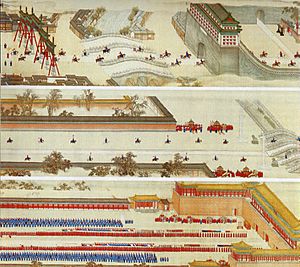
By October 1644, the Manchus had taken control of northern China. Prince Regent Dorgon announced that the Qing dynasty would now rule China. A special ceremony was held at the Forbidden City to declare the young Shunzhi Emperor as the new ruler.
The Qing rulers kept most of the palace's design from the Ming dynasty. However, they changed the names of some important buildings. Ming dynasty names often used words meaning "supremacy," while Qing names preferred words meaning "peace" and "harmony." For example, the "Hall of Imperial Supremacy" became the "Hall of Supreme Harmony."
Also, signs and name plates in the palace were written in both Chinese and Manchu. The main part of the empress's bedroom became a Shamanist shrine.
The Forbidden City became the power center of the Qing dynasty. In 1860, during the Second Opium War, British and French forces took control of the Forbidden City for a time. In 1900, Empress Dowager Cixi fled the city during the Boxer Rebellion, and foreign forces occupied it until the next year.
After being home to 24 emperors (14 from the Ming dynasty and 10 from the Qing dynasty), the Forbidden City stopped being China's political center in 1912. This happened when Puyi, the last emperor, gave up his throne. However, an agreement allowed Puyi and his family to continue living in the Inner Court of the Forbidden City. The Outer Court was given to the new government, and a museum was set up there in 1914.
After the Revolution
Many people in the new Republic of China did not like the idea of Puyi still living in the palace.
In 1923, Reginald Johnston, Puyi's English teacher, warned him that palace staff were secretly taking treasures and selling them. Puyi ordered a check of the palace's collections. But before it could start, a fire destroyed the gardens of the Palace of Establishing Prosperity. Many valuable artworks were stored there. Puyi believed the fire was started by the staff to hide what they had stolen. This fire made the public even more upset about Puyi staying in the palace. The gardens were not rebuilt until 2005.
In 1924, a general named Feng Yuxiang took control of Beijing. He ended the agreement with the Qing imperial family and made Puyi leave the palace. On October 10, 1925, the Palace Museum officially opened in the Forbidden City. The many treasures there were slowly organized and put on display for everyone to see.
Protecting the Treasures
Later, the Japanese invasion of China put these national treasures at risk. Starting in 1933, important artifacts were carefully packed and moved out of the Forbidden City. They were first sent to Nanjing, then to Shanghai.
But the Japanese forces soon threatened Shanghai. So, the government decided to move the collections to safer places in the remote west of China. The artifacts were divided into three groups. Each group traveled a different route, often moving quickly to escape bombings and capture. Amazingly, all three collections reached safety in Sichuan province, where they stayed until the war ended.
During this time, the Japanese army captured the Forbidden City in Beijing. However, they were only able to take a few large bronze tubs and cannons. Most of these were found and returned after the war.
At the end of World War II in 1945, the artifacts were moved back to Nanjing and Beijing. It's remarkable that none of them were damaged or lost during all that moving!
In the late 1940s, during the Chinese Civil War, Chiang Kai-shek ordered some of the best collections from Nanjing to be moved to Taiwan. These treasures now form the main collection of the National Palace Museum in Taipei.
Under the People's Republic of China
In 1949, the People's Republic of China was announced at Tiananmen, right in front of the Forbidden City. For the next 20 years, there were ideas to tear down or change the Forbidden City to make parks or entertainment areas.
The Forbidden City did suffer some damage during this time. For example, the emperor's throne in one hall was taken apart, and name plates were removed from some buildings. Some smaller gates and structures were also torn down.
The damage was worst during the Cultural Revolution. In 1966, one hall was changed for an exhibition, and some artifacts were destroyed. However, more destruction was stopped when Premier Zhou Enlai sent an army group to guard the city. These soldiers also prevented groups from damaging the city. From 1966 to 1971, all gates to the Forbidden City were sealed, which saved it from more harm.
In 1987, UNESCO again declared the Forbidden City a World Heritage Site. They recognized it as the "Imperial Palace of the Ming and Qing Dynasties" because of its important role in Chinese architecture and culture.
The Forbidden City Today
Today, the Palace Museum is in charge of protecting and restoring the Forbidden City. There are rules about how tall buildings can be around the Forbidden City to protect its views. In 2005, a 16-year project began to repair and restore all the buildings to how they looked before 1912. This is the biggest restoration of the Forbidden City in 200 years! Parts of the city are closed off one by one for repairs.
As part of this project, some damaged or destroyed areas are being rebuilt. The gardens of the Palace of Establishing Prosperity, which burned down in 1923, were rebuilt in 2005. However, they are not open to the public. These buildings are now used for important visitors.
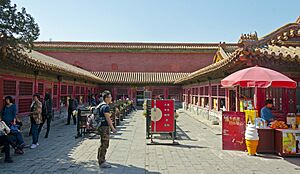
While efforts are made to keep the palace from becoming too commercial, you can find souvenir shops and photography stands there.
In 2005, IBM Corporation and the Palace Museum started a project to create a virtual model of the Forbidden City online. This project, called The Forbidden City: Beyond Space and Time, lets people explore the palace in 3D from anywhere in the world. It includes about 800 buildings and launched in 2008.
See also


